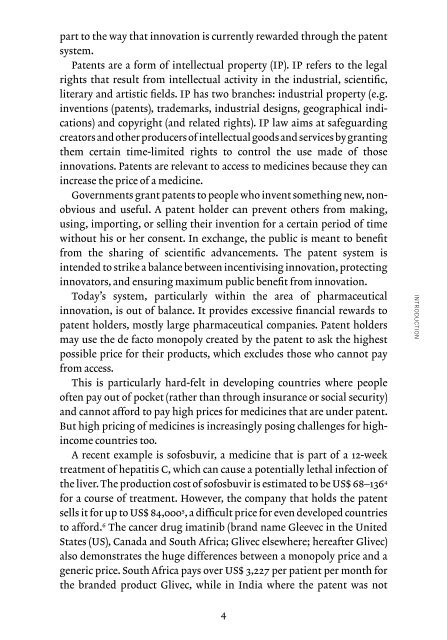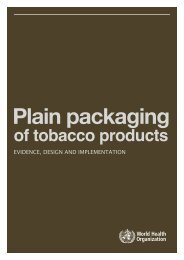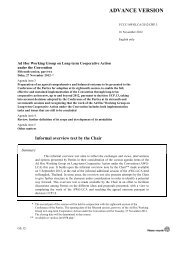PRIVATE PATENTS AND PUBLIC HEALTH
private-patents-and-public-health
private-patents-and-public-health
Create successful ePaper yourself
Turn your PDF publications into a flip-book with our unique Google optimized e-Paper software.
part to the way that innovation is currently rewarded through the patent<br />
system.<br />
Patents are a form of intellectual property (IP). IP refers to the legal<br />
rights that result from intellectual activity in the industrial, scientific,<br />
literary and artistic fields. IP has two branches: industrial property (e.g.<br />
inventions (patents), trademarks, industrial designs, geographical indications)<br />
and copyright (and related rights). IP law aims at safeguarding<br />
creators and other producers of intellectual goods and services by granting<br />
them certain time-limited rights to control the use made of those<br />
innovations. Patents are relevant to access to medicines because they can<br />
increase the price of a medicine.<br />
Governments grant patents to people who invent something new, nonobvious<br />
and useful. A patent holder can prevent others from making,<br />
using, importing, or selling their invention for a certain period of time<br />
without his or her consent. In exchange, the public is meant to benefit<br />
from the sharing of scientific advancements. The patent system is<br />
intended to strike a balance between incentivising innovation, protecting<br />
innovators, and ensuring maximum public benefit from innovation.<br />
Today’s system, particularly within the area of pharmaceutical<br />
innovation, is out of balance. It provides excessive financial rewards to<br />
patent holders, mostly large pharmaceutical companies. Patent holders<br />
may use the de facto monopoly created by the patent to ask the highest<br />
possible price for their products, which excludes those who cannot pay<br />
from access.<br />
This is particularly hard-felt in developing countries where people<br />
often pay out of pocket (rather than through insurance or social security)<br />
and cannot afford to pay high prices for medicines that are under patent.<br />
But high pricing of medicines is increasingly posing challenges for highincome<br />
countries too.<br />
A recent example is sofosbuvir, a medicine that is part of a 12-week<br />
treatment of hepatitis C, which can cause a potentially lethal infection of<br />
the liver. The production cost of sofosbuvir is estimated to be US$ 68–136 4<br />
for a course of treatment. However, the company that holds the patent<br />
sells it for up to US$ 84,000 5 , a difficult price for even developed countries<br />
to afford. 6 The cancer drug imatinib (brand name Gleevec in the United<br />
States (US), Canada and South Africa; Glivec elsewhere; hereafter Glivec)<br />
also demonstrates the huge differences between a monopoly price and a<br />
generic price. South Africa pays over US$ 3,227 per patient per month for<br />
the branded product Glivec, while in India where the patent was not<br />
INTRODUCTION<br />
4






